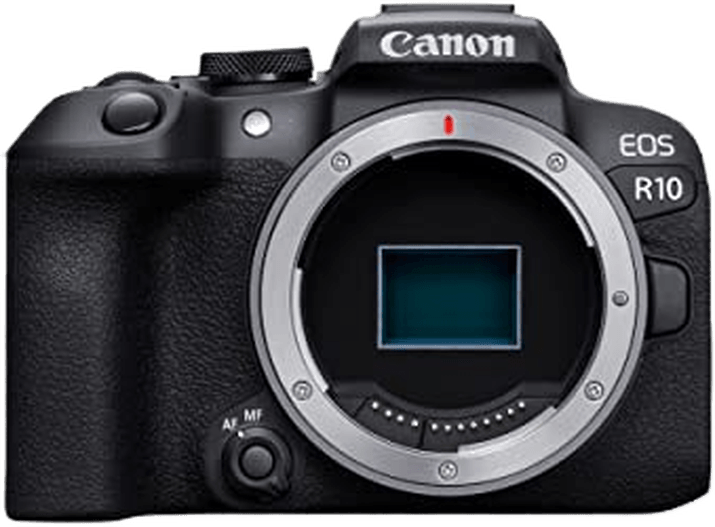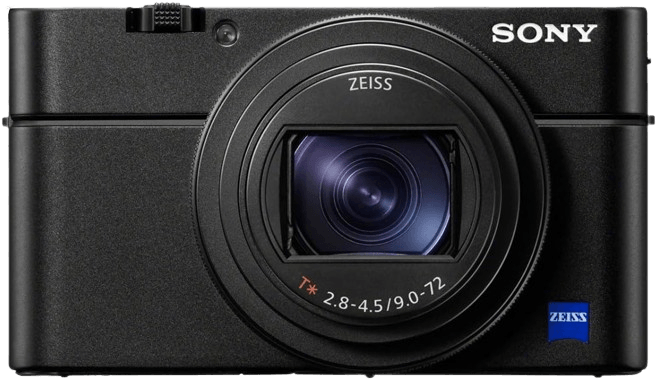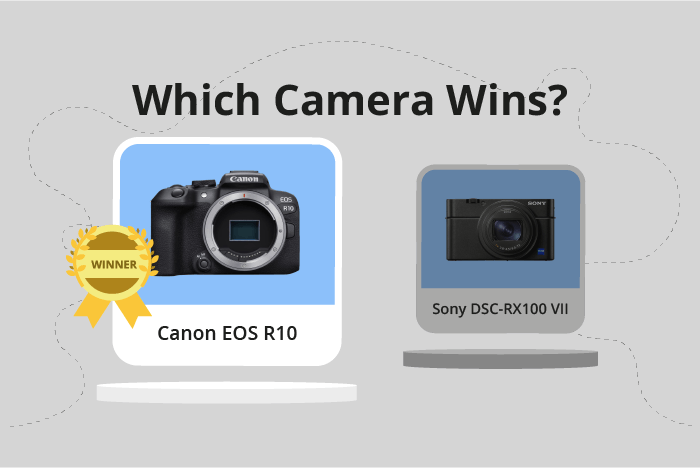Canon EOS R10 vs Sony Cyber-shot DSC-RX100 VII Comparison
Canon EOS R10

Sony RX100 VII

The Canon EOS R10 outperforms the Sony Cyber-shot DSC-RX100 VII with a score of 69/100 compared to 60/100. Both cameras share similarities, such as being released in the 2010s and having high launch prices, with the R10 at $980 and the RX100 VII at $1200.
The R10 sets itself apart with its mirrorless design, larger size (123 x 88 x 83mm), and heavier weight (426g/0.94lbs). This design offers better image quality and performance. On the other hand, the RX100 VII is a compact camera, smaller (102 x 58 x 43mm), and lighter (302g/0.67lbs), making it more portable and convenient for casual users.
Considering the specifications, the Canon EOS R10 is a better choice for those seeking superior image quality and performance, while the Sony Cyber-shot DSC-RX100 VII offers a more portable option for casual photographers.
Canon EOS R10 vs Sony Cyber-shot DSC-RX100 VII Overview and Optics
The Canon EOS R10 outperforms the Sony Cyber-shot DSC-RX100 VII in optics, scoring 71 out of 100 versus the Sony’s 61. Both cameras share similarities in their specifications, such as having CMOS sensors and similar megapixel counts – 24 for the Canon and 20 for the Sony.
The Canon EOS R10 excels with its higher shooting speed of 15 compared to the Sony’s 5, making it more suitable for capturing fast-moving subjects. Additionally, the Canon features a more powerful Digic X processor and a larger APS-C sensor, contributing to its higher DXOMARK score of 97 as opposed to the Sony’s 63. The Canon also benefits from a versatile Canon RF lens mount, allowing users to swap lenses for various shooting situations.
On the other hand, the Sony Cyber-shot DSC-RX100 VII has the advantage of built-in image stabilization, which can help reduce camera shake and improve image quality in certain conditions. However, its fixed lens mount limits users to a single lens option.
Taking these factors into account, the Canon EOS R10 is the superior choice for photographers seeking better overall optics performance, a faster shooting speed, and the flexibility of interchangeable lenses. Meanwhile, the Sony Cyber-shot DSC-RX100 VII may be better suited for casual photographers who prioritize convenience and image stabilization over lens versatility and speed.
Canon EOS R10 vs Sony Cyber-shot DSC-RX100 VII Video Performance
The Canon EOS R10 and the Sony Cyber-shot DSC-RX100 VII tie in their video capabilities, both scoring 91 out of 100. These cameras share several specifications, including a maximum video resolution of 4K, video dimensions of 3840 x 2160, a maximum frame rate of 120fps, and built-in time-lapse functionality.
The Canon EOS R10 stands out due to its superior ergonomics and design, making it easier to shoot videos for extended periods. Additionally, the EOS R10 is a suitable choice for those who require a camera that is easy to handle and operate while capturing videos.
On the other hand, the Sony Cyber-shot DSC-RX100 VII excels in its compact size and portability. This camera is an excellent choice for users who prioritize a smaller form factor for easy transport and storage. Despite its smaller size, the RX100 VII does not compromise on video quality, matching the EOS R10 in performance.
Both cameras offer impressive video capabilities, making them suitable choices for different users. The Canon EOS R10 is ideal for those who prefer a robust and ergonomic design, while the Sony Cyber-shot DSC-RX100 VII is perfect for those who value portability and a compact form factor. Ultimately, either camera will deliver high-quality video performance, and the choice between them depends on the user’s specific needs and preferences.
Canon EOS R10 vs Sony Cyber-shot DSC-RX100 VII Features and Benefits
The Canon EOS R10 wins the features comparison with a score of 70/100, while the Sony Cyber-shot DSC-RX100 VII follows closely with 68/100. Both cameras share several specifications, including a 3-inch screen size, touchscreen capabilities, flip screens, and no GPS. Additionally, both cameras are equipped with WIFI and Bluetooth connectivity.
The Canon EOS R10 surpasses the Sony Cyber-shot DSC-RX100 VII in screen resolution, boasting 1,040,000 dots compared to Sony’s 921,000 dots. This higher resolution provides the EOS R10 with a clearer and more detailed display, making it easier for photographers to review their shots and navigate menus.
Although the Sony Cyber-shot DSC-RX100 VII has a slightly lower feature score, it still offers a competitive set of features, matching the Canon EOS R10 in most aspects. The two-point difference in score does not significantly impact the overall performance and user experience of the camera.
Considering the close scores and shared specifications, both the Canon EOS R10 and the Sony Cyber-shot DSC-RX100 VII offer photographers a solid set of features to enhance their photography experiences. The Canon EOS R10’s higher screen resolution gives it an edge in display quality, while the Sony Cyber-shot DSC-RX100 VII remains a strong contender with its nearly identical specifications. Ultimately, photographers should weigh their personal preferences and requirements when choosing between these two cameras, as their feature sets are remarkably similar.
Canon EOS R10 vs Sony Cyber-shot DSC-RX100 VII Storage and Battery
The Canon EOS R10 outperforms the Sony Cyber-shot DSC-RX100 VII in storage and battery with a score of 40/100, while the Sony camera scores 29/100. Both cameras share similarities, such as having a single memory card slot and accepting SD, SDHC, and SDXC memory cards. They also both offer USB charging capabilities.
The Canon EOS R10 excels with its longer battery life of 450 shots, compared to the Sony’s 260 shots. The Canon camera utilizes an LP-E17 battery type, which contributes to its superior battery performance.
On the other hand, the Sony Cyber-shot DSC-RX100 VII has the added benefit of accepting Memory Stick Pro Duo cards, providing users with an additional storage option. However, this advantage does not outweigh the significant difference in battery life between the two cameras.
In the end, the Canon EOS R10 proves to be the better choice for storage and battery performance, while the Sony Cyber-shot DSC-RX100 VII offers a minor advantage with an extra memory card compatibility.
Canon EOS R10 vs Sony Cyber-shot DSC-RX100 VII – Our Verdict
Are you still undecided about which camera is right for you? Have a look at these popular comparisons that feature the Canon EOS R10 or the Sony Cyber-shot DSC-RX100 VII:

